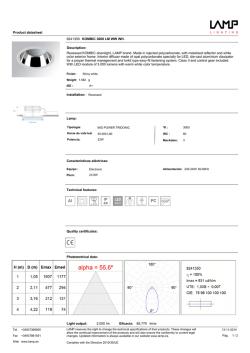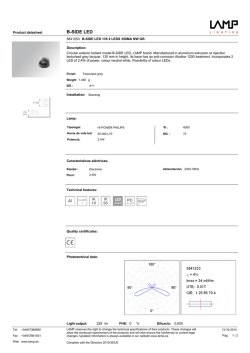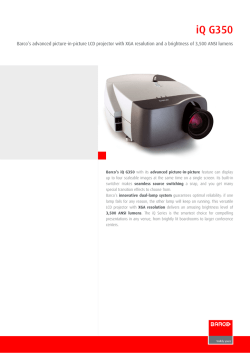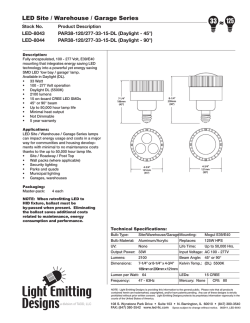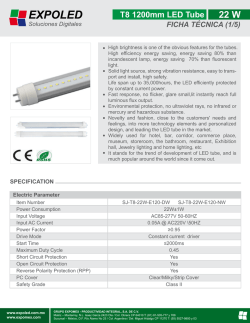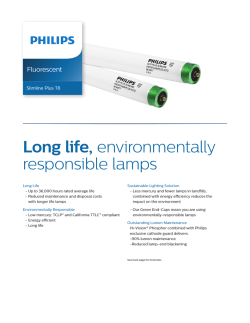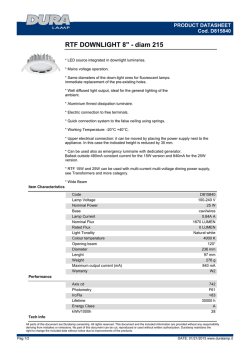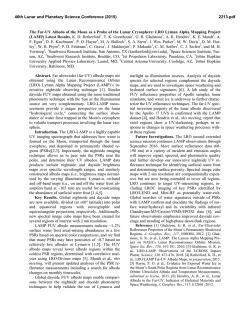
Multiple-Layer Heat Dissipation Module for LED Streetlamps
Journal of Applied Science and Engineering, Vol. 15, No. 2, pp. 97-104 (2012) 97 Multiple-Layer Heat Dissipation Module for LED Streetlamps Shung-Wen Kang*, Kun-Cheng Chien and Wei-Chung Lin Department of Mechanical and Electro-Mechanical Engineering, Tamkang University, Tamsui, Taiwan 251, R.O.C. Abstract High-powered light-emitting diodes (LED) have rapidly developed in recent years from applications in indication devices to wider uses in illumination devices. This study proposed an innovative heat dissipation module for an LED street lamp using a number of substrates positioned in multiple-layer formation. Multi-chip LED arrays were mounted on each substrate. Heat generated by the LEDs was dissipated through a heat dissipation plate formed by the substrates, which connected to heat pipes and a heat sink. This study used several simulation models to determine the natural convection properties of the proposed module. Based on the simulations, a heat dissipation module was manufactured. Module temperatures were measured and compared with simulation results at input powers of 120 and 180 W. Illuminance tests were also conducted to verify the performance of the LED lamp. The multiple-layer substrates were shown to instantly and effectively dissipate heat outward and prevent degradation in the illumination quality of the LED lamp. Key Words: Heat Pipe, Heat Sink, LED, Multiple-Layer Substrates, Nature Convection 1. Introduction Light-emitting diodes (LEDs) are p-n junction devices constructed from semiconductor materials, such as gallium arsenide (GaAs), gallium arsenide phosphide (GaAsP), or gallium phosphide (GaP). Silicon and germanium are unsuitable for use in LEDs because these junctions produce heat with no appreciable infrared (IR) or visible light. The junction in LEDs is forward biased. When electrons cross the junction from the n- to the p-type material, the electron-hole recombination process produces photons in a process called electroluminescence. An exposed semiconductor surface can then emit light. Wavelength size is related to the energy gap of the material. Materials with larger energy gaps produce shorter wavelengths [1]. Two primary approaches can be used to obtain white light from LEDs. The first method is *Corresponding author. E-mail: [email protected] to combine light from red, green, and blue LEDs. White light formed in this manner can be “tuned” to appear warm or cool by adjusting the amounts of each color in the mix. The second method uses a blue LED with a phosphor coating. The coating emits a yellow light when the blue light from the LED shines on it. The mix of the yellow light with the blue light forms a white light. Inefficiency in phosphor conversion is one reason that a white LED is less efficient than a colored LED. Some light energy is lost in the conversion to yellow [2]. LED epitaxial layers emit heat energy focused on small areas. When an LED lamp with numerous diodes is switched on, the temperature of the lamp increases rapidly as the LEDs or LED modules within emit heat. If the heat is not well dissipated, it may cause flickering and degrade the illumination quality of the LED lamp. It may also shorten the service life of the lamp. Thermal management and control are therefore major issues in solid-state lighting products. Various solutions have been proposed, as outlined below. 98 Shung-Wen Kang et al. Kim et al. performed thermal analysis on an LED array system with a heat pipe in 2007 [3]. Their study showed that a heat pipe effectively decreased the total thermal resistance of the LED array. The heat pipe was a good solution for controlling the junction temperature of high-powered LED systems. In 2009, Lai et al. proposed an indoor LED lighting prototype that used pressed-flat grooved heat pipes as heat transfer channels to conduct heat emitted by LEDs to heat-sink fins [4]. Single layered heat dissipation module in the above design can not provide a reliable solution in high power LED streetlamps. The goal of this study was to effectively conduct heat away from a LED street lamp prototype using a multilayered heat dissipation module. The thermal performance of the proposed module was simulated and experimentally tested at different input powers. conductor was connected to the heat sinks by one vertically placed heat pipe (8 mm in diameter, 125 mm in length) and two horizontally placed heat pipes (6 mm in diameter, 182 mm in length). Heat was dissipated to the heat-sink fins through the heat pipes. The multiple-layer substrate structure was designed for optimal heat dissipation for the LED street lamp. As opposed to traditional designs, the multi-chip LED arrays were installed in a number of substrates to increase the cooling areas. This design for an LED street lamp 2. Experiment In JEDEC Standard No. 51-1 [5], the thermal resistance of a single semiconductor device is defined as (1) Figure 1. Schematic of LED street lamp with heat dissipation module. with Rtotal being the thermal resistance between the LED device and the specific environment, Th being the temperature of the LED multi-chip device in a steady state condition, Ta being the reference temperature for the specific environment, and Pin being the power dissipation in the device. 2.1 Heat Dissipation Module Figures 1 and 2 show the schematic illustration and cross-section of the LED street lamp with heat dissipation module. The heat dissipation module included a number of substrates positioned in multiple layers. Each substrate had a multi-chip LED array mounted on a copper block conductor. As shown in Figure 2, the module had two main layers. The middle LED light source was arranged on the lower layer. The module contained three copper block conductors, nine heat pipes, and several arrays of heat sinks. LED light sources were 36 mm in length, 36 mm in width, and 19.5 mm in height. They were fastened tightly to copper block conductors. Each Figure 2. Cross-section of the LED street lamp with heat dissipation module. Multiple-Layer Heat Dissipation Module for LED Streetlamps with natural convection devices used glass shade and a DC power control system. 2.2 Software Simulation Analysis ICEPAK software was used to analyze the heat distribution of the LED street lamp design. The simulations assumed that three LED multi-chips generated heat of 120 and 180 W because each multi-chip was 40 and 60 W. The temperature of the environment was 30 °C, a normal ambient temperature for an LED street lamp. 2.3 Fabrication and Testing We constructed a LED street lamp with heat dissipation module based on the model generated by ICEPAK. We spread thermal grease on the joint area to reduce contact thermal resistance. The prototype is shown in Figure 3. One LED multi-chip contained 40 single-watt LED chips connected with 10 serial connections and 4 parallel connections (Figure 4). The DC power supply was 350 mA, supplying each LED multi-chip with 40 W by 28.6 V and 1.4 A. Figure 5 shows the test-board built in a darkroom for gathering temperature and illuminance data. We determined the relationship between time and weakness of Figure 3. The prototype of LED street lamp. 99 illuminance and calculated the thermal resistance. A darkroom with natural convectional cooling conditions was necessary for testing the LED street lamp. Temperature distributions were measured with a T-type thermo- Figure 4. Diagram of LED multi-chip. Figure 5. Diagram of test-board. 100 Shung-Wen Kang et al. couple (range of approximately 100-400 °C), as shown in Figure 6. TC1 to TC6 were the temperature measurement points on the copper block conductors. 2.4 Planning and Measurement Illuminance is one of the main considerations in an LED lamp. We used the range of light distribution to measure the performance of the LED light source to determine the optimal design for an LED lamp. Figure 7(a) shows the experimental setup for measuring the LED lamp’s performance. We connected the lamp to a power supply and placed a light meter directly below the light source. We designated a 400 ´ 200 cm rectangular area as the area to be lit by our light source. This area was divided into several smaller rectangular grids (25 ´ 25 cm), each with four measuring points. There were a total of 153 measuring points. The lamp was centered on the edge of the area, as shown in Figure 7(b). 3. Results and Discussion 3.1 Results of Software Simulation Software simulations of the heat generated by the LED street lamp are shown in Table 1. Input power was set at 120 and 180 W and environmental temperature was set at 30 °C. Temperature distributions were recorded (Figures 8-9). The results were used to design the heat dissipation module. This design can be replicated using the gap between the heat sink and the device, number of heat pipes, and the relationship between the components. 3.2 Thermal Analysis A T-type thermocouple was used to record three temperatures at the LED heat sink slug. Average temperatures were compared with simulation temperatures. Table 1. Temperature results from software simulation Software Figure 6. Diagram of picked positions by temperature. ICEPAK Input power 120 W 180 W Average temp. of LED (°C) Average temp. of copper block (°C) Average temp. of heat pipe (°C) Average temp. of heat sink (°C) 61.1 °C 60.9 °C 60.5 °C 60.2 °C 69.45 °C 69.30 °C 68.48 °C 68.23 °C Figure 7. Diagram of the illuminance measurement. Multiple-Layer Heat Dissipation Module for LED Streetlamps 101 Figure 8. Temperature distribution of simulation at 120 W. Figure 9. Temperature distribution of simulation at 180 W. We determined the relationship between time of use and temperature at an input of 120 W. Figure 10 shows that after 40 min, the temperature gradually approached a steady state. The temperatures of the LED heat sink slug ranged from 55.6 to 57.1 °C. The average steady state temperature of the LED heat sink slug was 56.1 °C. 102 Shung-Wen Kang et al. The lamp’s ambient temperature was between 25.2 and 29.7 °C. At an input of 180 W, the relationship between time of use and temperature was different. Figure 11 shows that after 30 min, the cooling module temperature gradually approached steady-state temperatures between 65.2 and 67.4 °C. The LED heat sink slug steady-state average temperature was 66.0 °C. The lamp’s ambient temperature was between 24.7 and 29.9 °C. In the simulation analysis, with an input of 120 W, the LED heat sink slug’s average temperature was 56.1 °C. The simulated copper block temperature was 60.9 °C. A 4.8 °C difference existed between actual and simulated temperatures. At an input of 180 W, the simulated LED heat sink slug’s average temperature was 66.0 °C. The simulated temperature of the copper block was 69.3 °C. A 3.3 °C existed between actual and simulated temperatures. With both differences not exceeding 5 °C, little error was shown to exist between simulated and ac- tual results (Figures 10 and 11). Figure 12 shows the overall thermal resistance of the LED lamp. At 120 and 180 W, the average steady state value of total thermal resistance was 0.24 °C/W and 0.22 °C/W, respectively. Figure 10. LED heat sink slug when temperature/time at 120 W. 3.3 Illuminance Analysis We performed an illuminance test at 120 W. The lamp was positioned 2 m above the center of the measurement location. The test area covered an area of 4 ´ 2 m with a measurement point at each 25 cm interval and a total of 153 measurement points, which comprised the set of illuminance test values. After 1 min, we obtained an average illuminance of 510 lux in the center. When the temperature reached a steady state, the average illuminance was 453 lux. We drew an illuminance plane map based on each measurement point. This showed eight levels of illuminance values. The maximum illuminance levels were in the center between 450 and 550 lux. The center of the illuminance distribution was in the shape of a polygonal water chestnut. The outer shape was hemispherical. This is shown in Figure 13. We performed the same illuminance test at 180 W. The lamp was positioned 2 m above the center of the measurement location. The test area covered an area of 4 ´ 2 m with a measurement point at each 25 cm interval and a total of 153 measurement points. After 1 min, we obtained an average illuminance of 670 lux in the center. When the temperature reached a steady state, the average illuminance was 558 lux. We drew an illuminance plane map based on each measurement point. This showed nine levels of illuminance values. The maximum illuminance levels were in the center between 550 and 600 Figure 11. LED heat sink slug when temperature/time at 180 W. Figure 12. Total thermal resistance compared with input power 120 and 180 W. Multiple-Layer Heat Dissipation Module for LED Streetlamps lux. The center of the illuminance distribution was in the shape of a polygon. The outer shape was hemispherical. This is shown in Figure 14. 4. Conclusion This study proposed to replace traditional street lamps with an LED street lamp containing a multilayered substrate structure for heat dissipation. We used simulation software to analyze the heat distribution for the proposed model. The simulation showed that our model 103 would be effective at dissipating heat in the LED lamp. We tested temperature changes at 120 and 180 W of inputted power. The LED heat sink slug’s average temperature remained in safe ranges. Less than 5 °C difference existed between actual and simulated results. The average thermal resistance values were 0.24 °C/W at 120 W and 0.22 °C/W at 180 W. The data showed that a multilayered substrate structure is not only able to improve LED efficiency but also to solve the heat dissipation issue in LED lamps. Illuminance is an important consideration in lamp de- Figure 13. Illuminance distribution at 120 W. Figure 14. Illuminance distribution at 180 W. 104 Shung-Wen Kang et al. sign. The illuminance tests showed that our LED lamp had a better illuminance distribution curve at 120 W than at 180 W. Patents Shung-Wen Kang and Kun-Cheng Chien, Led Lamp Instantly Dissipating Heat As Effected By MultipleLayer Substrates, Patent Number US 7,607,802 B2, Date of patent, October 27,2009. References [1] Vaccaro, P. O., “Lateral P–N Junctions for High-Density LED Arrays,” Microelectronics Journal, Vol. 34, pp. 355-357 (2003). [2] Information on http://www.lumileds.com/. [3] Kim, L. J., Choi, H., Jang, S. H. and Shin, M. W., “Thermal Analysis of LED Array System with Heat Pipe,” Thermochimica Acta, Vol. 455, pp. 21-25 (2007). [4] Lai, C. M., Chiang, C. M. and Ho, C. J., “Thermal Performance of an Indoor Oblong LED Lighting Prototype Incorporating Heat Pipes,” Journal of Asian Architecture and Building Engineering, Vol. 8, pp. 585-592 (2009). [5] EIA/JEDEC Standard No. 51-1, December (1995). Manuscript Received: Feb. 20, 2012 Accepted: Jun. 4, 2012
© Copyright 2025
